Construction
The Complete Guide to AI Construction Document Review for Project Management
October 15, 2025 • 102 Views • 20 min read
Bohdan Vasylkiv
CEO & Co-Founder
Construction is one of the most document-intensive industries globally. Every project, whether it involves one building or a massive infrastructure project, generates thousands of documents, including contracts, designs, RFIs, invoices, safety reports, permits, and warranties.
Conquering this summit of information has always been a challenge. Project managers spend more time chasing documents, clarifying versions, or searching for approvals than they do coordinating construction activities themselves.
Artificial intelligence is transforming this reality. AI construction document review isn't about scanning documents; it's about making documents easily manageable. It is driven by a combination of technologies, which allow Artificial intelligence to automatically read, classify, and route documents with high accuracy. Instead of project teams typing data for hours or filing, the system does it in a second, correctly, and at scale.
This article examines how AI document assistants are revolutionizing document management in construction companies. Here, you will learn how adopting AI is more about unlocking the optimal potential of your projects, rather than cutting through red tape.
Why Document Processing is Essential in Construction
Documentation has proved to be a two-edged sword in construction from day one. On the positive side, it serves as a foundation for accountability, compliance, and communication within involved projects. On the negative, the sheer magnitude renders it almost impossible to process efficiently using conventional methods.
Consider a run-of-the-mill large project:
The design process alone generates hundreds of drawings and specifications, each of which must undergo revisions and updates. Procurement staff oversee contracts with dozens of subcontractors and suppliers.
At the same time, site activities generate daily field reports, inspection logs, safety checklists, and RFIs (Requests for Information), while Finance departments must process invoices, progress payments, and change orders. During project closeout, all relevant materials, including warranties and operations manuals, must be compiled into a final handover package for the client.
When only one document is delayed, misclassified, or lost, the ripple effect is dramatic. An RFI not responded to can hold up major work. An absent permit can shut down inspections. A current but outdated drawing in the system can trigger rework costing millions. Latest statements suggest that up to one-fifth of rework in the construction sector is caused by inaccurate or unavailable project data, costing billions of dollars in unnecessary costs each year.
This is precisely why construction AI in document management has become a strategic necessity. Organizations that can deliver the correct documents to the proper people at the right time have a competitive advantage. AI is the force behind making this happen at scale.
How AI Construction Document Review Works
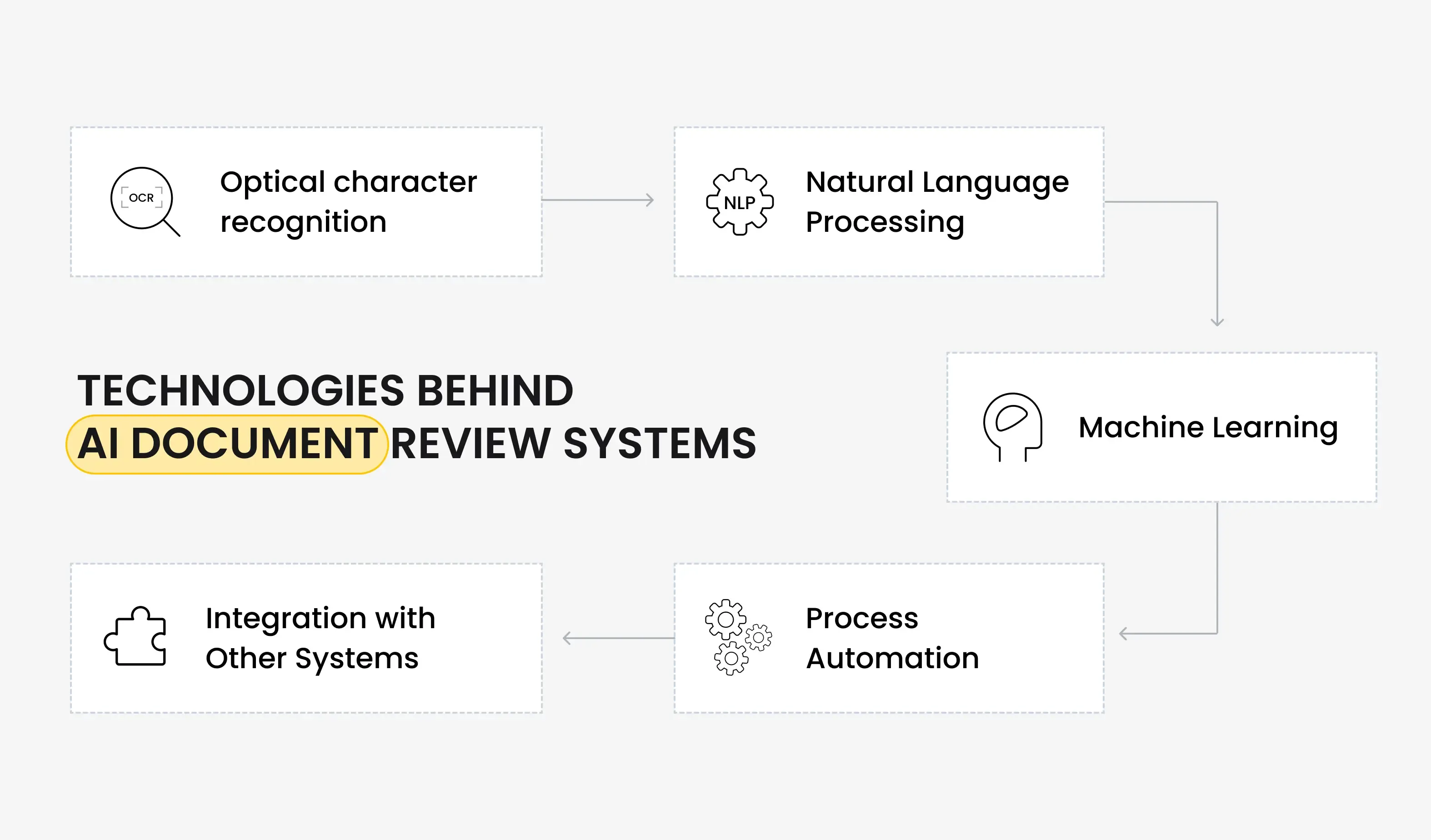
Fundamental to an AI-based document processing solution is the ability to transform unstructured or semi-structured information into actionable and usable information. Traditional systems treat documents as fixed files. AI systems read them, extract meaning, and incorporate them into workflows.
Basically, five main technologies and processes enable such AI-driven document processing:
- Optical character recognition (OCR)
- Natural language processing (NLP)
- Machine learning (ML)
- Process automation
- Integration with other systems
The process usually begins with optical character recognition, which converts scanned contracts, invoices, or inspection reports into a form readable by computers. More advanced versions, known as intelligent character recognition, expand upon this capability and utilize it to interpret handwritten reports or documents that are inadequately scanned, a common situation in field operations.
As soon as text is extracted, natural language processing takes control. NLP allows the system to read meaning and context. For instance, it can determine whether a document is an RFI or a submittal, identify key dates and stakeholders, or flag clauses that may reflect risk in a contract.
Machine learning is involved. Using training data in the form of thousands of past documents, algorithms learn to recognize patterns and to predict document types or fields more precisely. The system improves over time as it is used more frequently. If a subcontractor consistently formats invoices in the same way, the AI can quickly learn to adjust, automatically extracting critical information without requiring manual configuration.
Lastly, there is AI business automation. Instead of simply stamping a document, artificial intelligence triggers the subsequent step of the process. An invoice can be routed for approval and auto-checked against a purchase order. A submittal can be routed to the correct engineer with a reminder of response times. Compliance documents are monitored, maintained in suspense for their expiration dates, and escalated when they are approaching their expiration dates.
Most significantly, AI document systems rarely operate in isolation. They are integrated with existing project management software, ERP systems, and BIM platforms, ensuring that information passes seamlessly across the company. A well-architected solution also includes a "human-in-the-loop" functionality where low-confidence results prompt human inspection, and fixes flow into the model for continuous improvement.
Benefits of Intelligent Document Processing
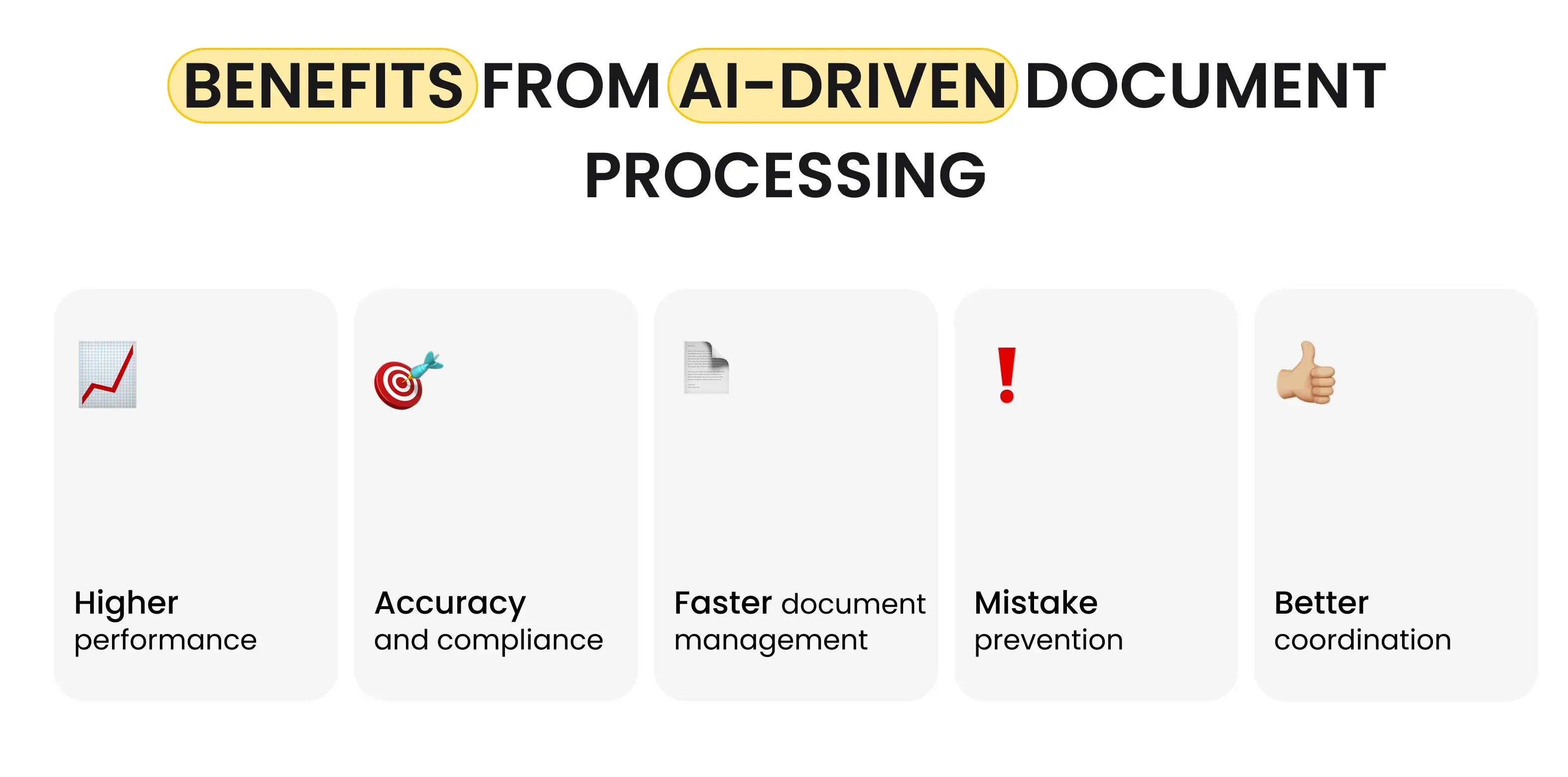
The benefits of AI-based document processing solutions are tangible; they can be quantified.
- Improved performance
- Higher accuracy & compliance
- Faster invoice processing
- Mismatch and overbilling detection
- Improve coordination
Productivity benefits are likely to be visible. By automating tedious manual activities such as data entry or document filing, AI enables project teams to focus on value-added tasks. For instance, A civil engineering firm that applies document automation can process over 100,000 pages with absolute accuracy, reducing processing time by nearly 80 percent and increasing throughput threefold.
Accuracy and compliance are yet another significant advantage. Construction projects are subject to stringent regulatory management, and misplaced or lost documents can mean costly penalties. AI systems reduce the likelihood of human error, enforce version control, and offer audit trails. Safety records, permits, and certificates are tracked automatically, so deadlines are never entered incorrectly.
The bottom-line benefits are equally appealing. Faster invoice processing ensures timely payment to suppliers, fosters relationship building, and prevents duplicate or fraudulent payments. Detecting mismatched items or overbilling at the early stages of the process helps avoid financial leakage. These savings accumulate into millions under large programs.
Finally, coordination is better. Instead of launching hours-long searches through folders or email threads by teams, all stakeholders can access the latest document at a moment's notice. Field workers can submit inspection reports directly from a smartphone, triggering workflows without needing to return to the office. Owners, designers, and contractors see one version of the truth.
AI Use Cases in Construction Projects
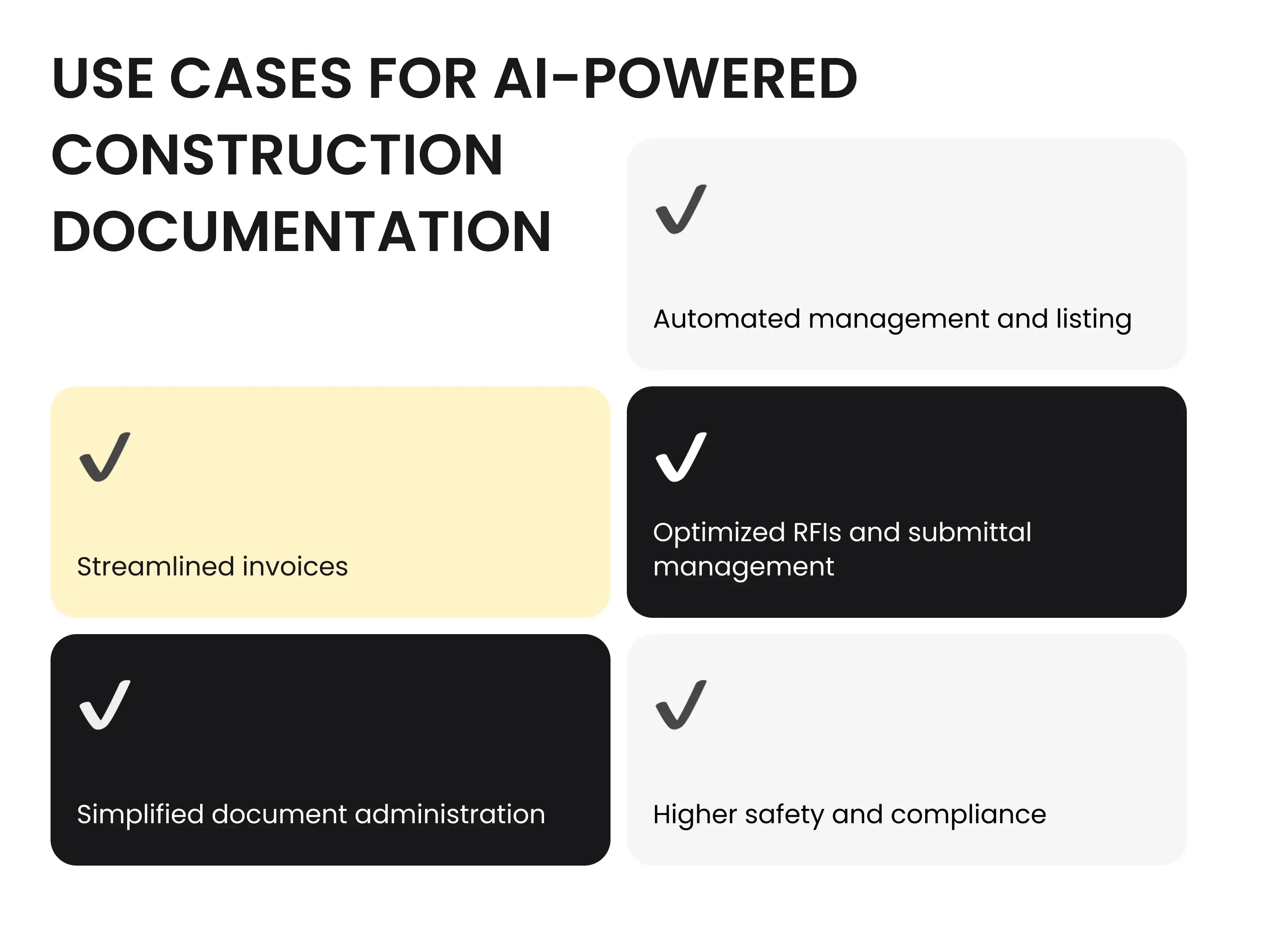
The potential of AI becomes most apparent when it is implemented within specialized construction workflows. Among the core use cases for AI document processing software are:
- Streamlined RFIs and submittal management
- Automated invoices
- Safety and compliance documentation control
- Simplified technical papers administration
- Overall documentation management & listing
One of the most significant pain areas is RFIs and submittal management. Traditionally, these documents lead to delays as they're recorded manually, routed via email, and followed up on using spreadsheets. Leveraging AI, an uploaded submittal is automatically classified, metadata is harvested, and it is routed to the respective reviewer. Deadline tracking is automated, and reminders are issued a day before the deadline is reached. Review loops are significantly minimized, allowing projects to proceed smoothly without any hitches.
Within the finance industry, automating invoices generates enormous value. Instead of typing line items into an accounting system, OCR reads totals, rates, and quantities. Machine learning matches them against purchase orders or contracts. Discrepancies—e.g., an invoice amount that exceeds the quoted rate—are flagged for a reviewer's attention. The invoice is routed automatically through a chain of approvals, reducing cycle times from weeks to days.
Safety and compliance documentation is another area in which AI stands out. Licenses, permits, and certifications expire after several years, but it is vulnerable to human mistakes if manually performed. AI construction document review checks for completeness, monitors expiry, and sends reminders well in advance, so projects never undergo regulatory shutdowns. Safety checklists can be electronically captured, assigned by risk category, and reviewed to identify recurring issues that require proactive action.
Even highly technical papers, such as engineering plans, benefit from this approach. Computer vision algorithms automatically read architectural and structural plans, recognizing objects such as walls, doors, or annotations. By comparing them with specifications or BIM models, AI can identify inconsistencies that might otherwise go undetected until they cause problems in the field.
Lastly, during project closure, AI will ensure that all required documents, ranging from as-built drawings to O&M manuals, are listed and in place. Rather than project teams taking weeks to bundle handover packages, the system builds them automatically into an organized digital deliverable, ready for handover to the client.
Documentation Challenges to Overcome with Agentic AI
Despite the apparent benefits, implementing AI in document processing presents several challenges.
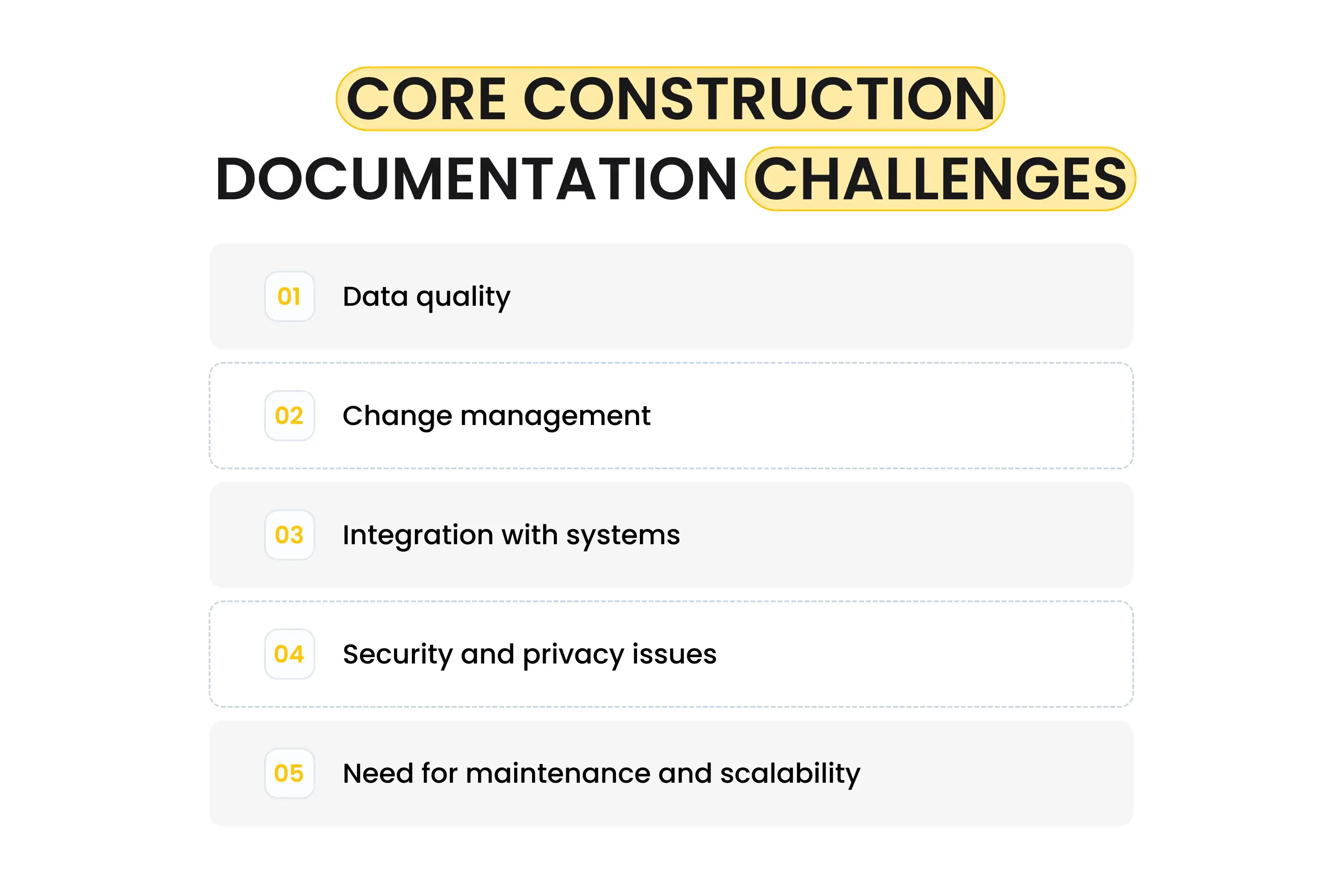
The first barrier is data quality. Poor-quality scanned documents, inconsistent formats, or illegible handwriting undermine AI accuracy. Firms must spend on digitization standards and data governance.
Change management is another entry barrier. Field workers habituated to legacy procedures may resist new systems if the advantages are not explained persuasively. Phased rollouts, training, and sponsorship by leadership are necessary to establish trust and foster adoption.
Integration is a technical problem. Most construction firms utilize a range of ERP systems, construction project management software, and similar systems, as well as BIM programs. The seamless integration of the AI construction document review solution will require vendors to be selected carefully, and sometimes customized development will be necessary.
Security and privacy also raise significant issues. Financial data and contracts are private, and publicizing them would have severe consequences. Therefore, platforms must offer role-based access, encryption, and granular audit trails.
Lastly, organizations must plan for maintenance and scalability. AI models evolve, and their performance suffers when they are not retrained periodically. Implementing MLOps practices, such as constant monitoring, retraining, and version management, is crucial to long-term success.
AI Construction Document Review Implementation Roadmap
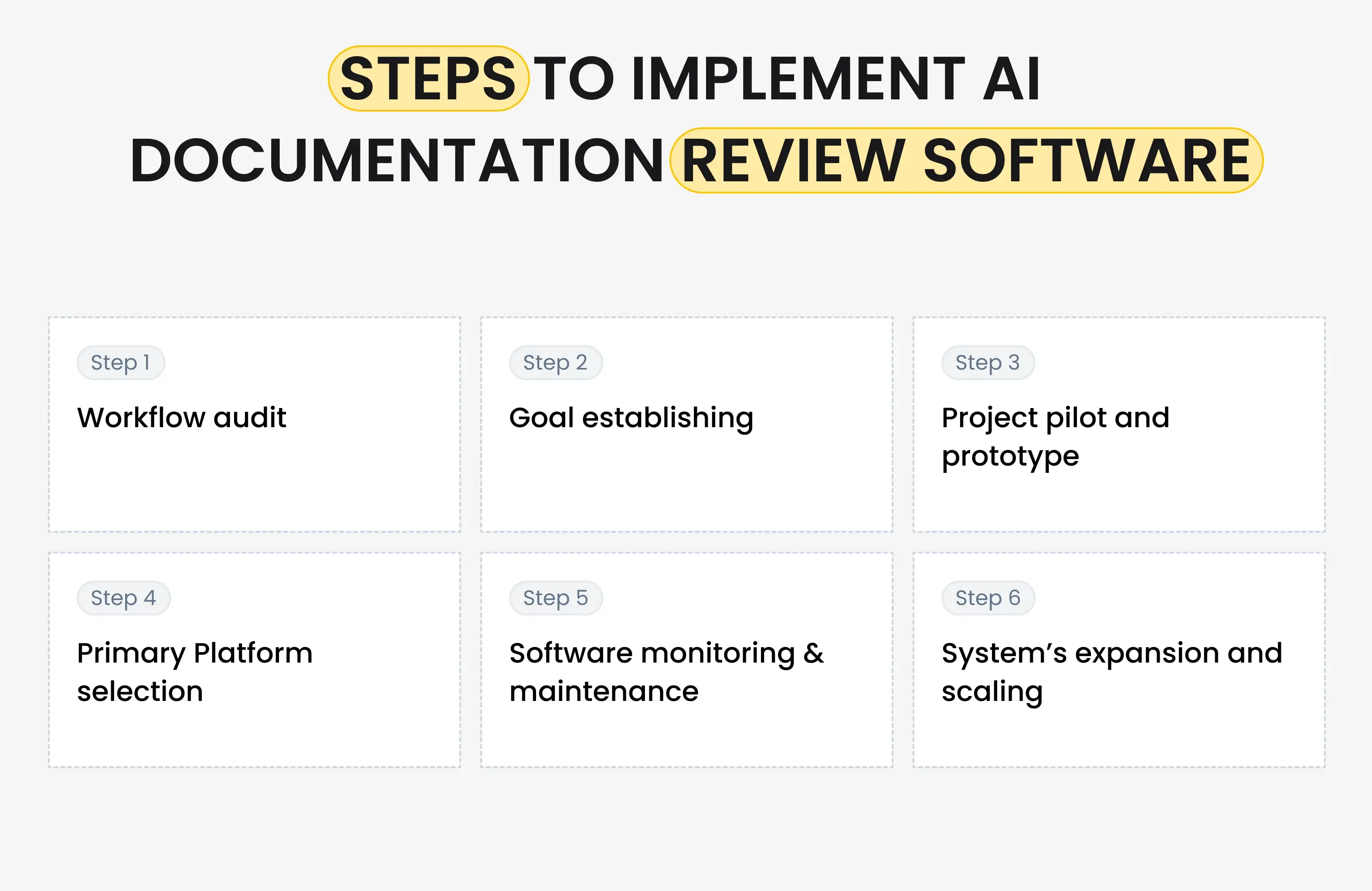
For organizations looking to adopt AI, a formalized roadmap is the best approach. The most basic roadmap should include the following steps:
- Workflow audit
- Establishing goal
- Pilot project
- Platform selection
- Monitoring and maintenance
- Scaling and expanding
It begins with a workflow audit. Developing existing process maps helps identify bottlenecks and quantify the time lost through manual processing. Once a baseline is established, the next step is to establish goals - whether that is reducing RFI turnaround time, speeding invoice approval, or improving compliance tracking.
It makes sense to start with a pilot project. Choosing one high-impact process allows teams to pilot the system, iterate, and demonstrate value without overwhelming the organization. Success early on creates momentum for broader adoption.
Platform selection is critical. Decision-makers will need to evaluate solutions based on their integration, scalability, and vendor support. Once chosen, the process involves data preparation and model training, giving the AI representative samples of real documents.
Monitoring is critical when it comes to deployment. Confidence scores, error rates, and user feedback must be continually monitored and evaluated to ensure optimal performance. Low-confidence cases can be sent for human intervention, which improves the system over time.
As the success is proven, the scope can be easily extended to other workflows. Training processes and change management initiatives familiarize users with the new process. Governance mechanisms, such as retraining the model and monitoring performance, help maintain system stability at scale.
The Future of AI in Construction Document Management
Generative AI is already writing contract terms, summarizing long documents, and generating negotiation briefs. Conversational interfaces allow field teams to dictate inspection reports, which are translated in real-time into data-rich reports. Predictive analytics will use document histories to forecast disputes or overruns before they occur.
Blockchain technology can also be combined with AI to provide immutable version histories of approvals and contracts, thereby increasing the trustworthiness of project data. When combined with digital twins, AI will help build environments where all drawings, reports, and inspections seamlessly integrate into a living model of the project.
As these competencies mature, AI document management will become an industry standard, rather than a competitive advantage, just as BIM adoption was before it. The firms that make early investments will not only reap cost savings and efficiency gains but also position themselves as the thought leaders in a rapidly expanding digitization market.
Why Build an AI Document Assistant with Incora?
Construction has never been straightforward with its paperwork. But this very same burden is one of the most significant opportunities for change. AI document processing software transforms what was once a source of vulnerability into a strength, streamlining processes, enforcing compliance, reducing risk, and ultimately accelerating project delivery.
The technology is out of beta. Real-world projects are already yielding measurable benefits, including shorter cycle times, lower costs, and fewer errors. The path forward is clear. By starting with individual pilots, investing in change management, and intelligently scaling, businesses can implement AI into their processes with confidence.
The question isn't whether AI will transform construction document management, but whether your business will lead or lag in embracing it.
If your business is poised to escape document disarray, it is time to move. Contact us today to schedule a complimentary consultation and learn how document processing with AI can be tailored to meet your specific construction needs. We can lead your construction project management software development project in the right direction.
What’s your impression after reading this?
Love it!
25
Valuable
12
Exciting
6
Unsatisfied
1
FAQ
Let us address your doubts and clarify key points from the article for better understanding.
What is AI document processing in construction?
AI document processing uses artificial intelligence to automatically read, classify, and route construction documents like contracts, RFIs, invoices, and safety reports. It transforms unstructured documents into actionable information through OCR, natural language processing, machine learning, and process automation.
How much can AI document processing reduce processing time?
AI can reduce document processing time by up to 80% while increasing throughput threefold. This allows project teams to focus on value-added tasks rather than manual data entry and document filing.
What types of construction documents can AI process?
AI can process contracts, designs, RFIs, invoices, safety reports, permits, warranties, inspection logs, field reports, progress payments, change orders, and technical drawings. It handles both structured and semi-structured documents effectively.
What are the main benefits of implementing AI document processing?
Key benefits include improved accuracy and compliance, faster invoice processing with fraud detection, enhanced coordination across stakeholders, reduced rework costs, automated deadline tracking, and elimination of version control issues.
What challenges should companies expect when implementing AI document processing?
Main challenges include ensuring data quality, managing change resistance from workers, integrating with existing systems, maintaining security and privacy, and planning for ongoing maintenance and model retraining.
How does AI improve RFI management in construction?
AI automatically classifies uploaded submittals, extracts metadata, routes documents to appropriate reviewers, tracks deadlines, sends automated reminders, and minimizes review loops, significantly reducing project delays.
What's the recommended approach for implementing AI document processing?
Start with a workflow audit to identify bottlenecks, establish clear goals, run a pilot project on one high-impact process, carefully select platforms based on integration capabilities, monitor performance continuously, and scale gradually across other workflows.
How does AI handle document security and compliance?
AI systems provide role-based access controls, encryption, granular audit trails, automated compliance tracking, and version control. They monitor permit and certification expiration dates to prevent regulatory issues.
you may also like
Management Systems
Construction Project Management Software for Small Business: Complete Guide
Construction
How AI Negotiation Agents Improve Construction Procurement [And Why Do You Need It]
Construction,
Real Estate
How Construction Workflow Management Software Helps to Reduce Costs and Boost Efficiency?
Construction
How Integrated BOQ Software Bridges the Gap Between Construction Departments
Construction
How to Create a Procore Alternative Software for a Construction Business
Construction
How to Deal With Weaknesses of Construction Financial Management Software?
Real Estate
How to Select the Right Construction Management Software for Your Business
Construction
Investing in the Right Construction Reporting Software: Features That Make a Difference
Construction
Is Voice Technology Worth the Investment for Construction Firms?
Construction
Overcoming Integration Challenges: Making Construction Data Work Together with BI Tools
Management Systems
Simple Construction Software for Construction Planning: Case Study
Let’s talk!
This site uses cookies to improve your user experience. Read our Privacy Policy
Accept
Share this article